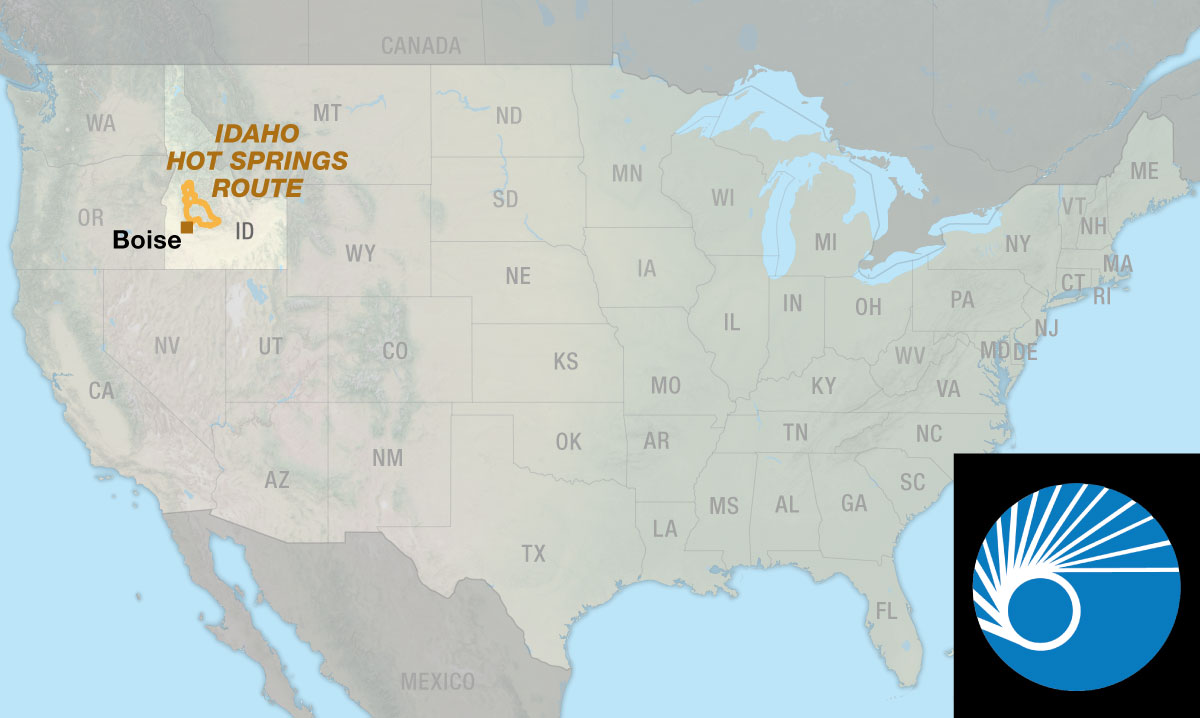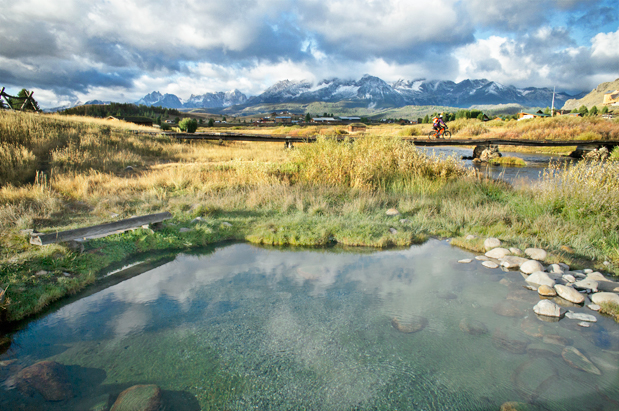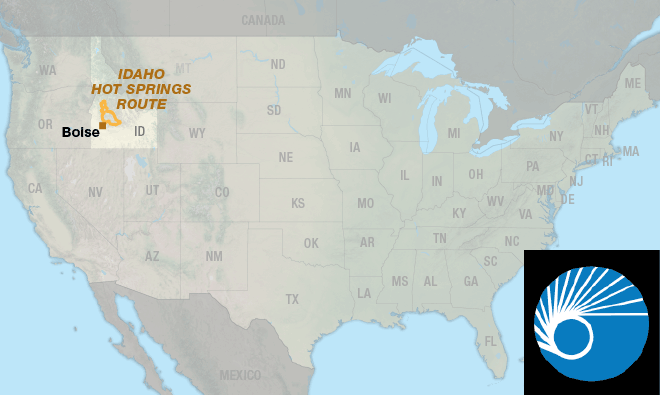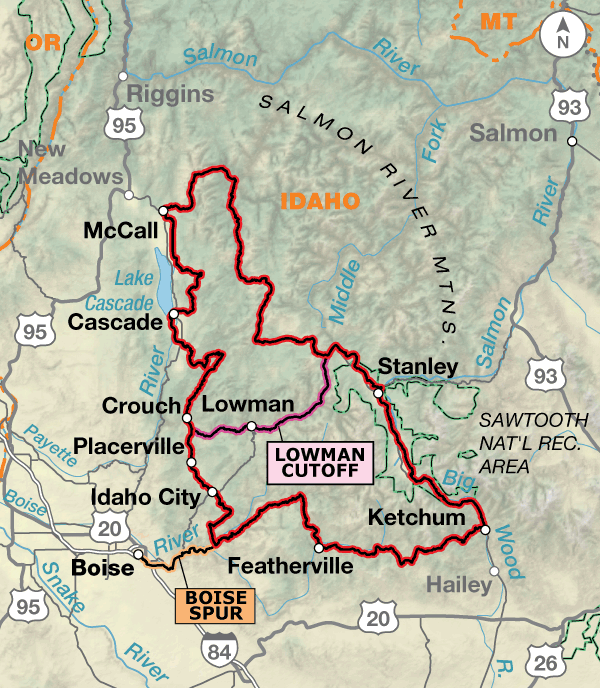Idaho Hot Springs Mountain Bike Route

Mountains, and Hot Springs, and Bikes, Oh My!
The Idaho Hot Springs Mountain Bike Route guides riders over and through the breathtaking landscape of central Idaho. From blue ribbon trout streams to sub-alpine terrain and cozy mountain towns, riders will pass through some of the most spectacular country the West has to offer, with the opportunity to indulge in the highest concentration of soakable hot springs in North America.

The route is divided into two maps. The Main Route Map contains routing for the main dirt road loop, the paved Lowman Cutoff, which divides the main dirt road loop in half, and the Boise Spur, which guides riders to and from the Boise Airport. The narratives for all routing on the Main Route Map are bi-directional.
The Singletrack Options Map contains routing for four unique singletrack options. The Singletrack Options Map is a supplement to the Main Route Map, and you will need to purchase both if choosing to incorporate any of the singletrack offerings into your adventure. The four singletrack options are not bi-directional. If you choose to ride them with the main route, you should go in a counter-clockwise direction.
ATTENTION On August 7, 2015, President Obama signed into law the creation of three new wilderness areas in the Boulder-White Clouds region of Idaho. One of these, the White Clouds Wilderness, encompasses trails we included in the White Clouds Option found on the 2014 version of the Singletrack Options Map of the Idaho Hot Springs Mountain Bike Route (IHSMBR). With the republication and update of the Singletrack Options IHSMBR map in November 2017, a new route avoiding the wilderness has been included. If you have the 2014 map, we advise purchasing the newer map.
A wide variety of road conditions exists along this route. Surfaces range from pavement, good gravel roads, four-wheel-drive roads, singletrack, and old railroad beds. Opportunities to spot wildlife such as black bears, deer, elk, eagles, osprey, and other birds and animals are in abundance on this route. The area is also rich in history with ghost towns, deserted mines, forgotten homesteads, and even the first ski lift erected in the country. The route features 50 hot springs. Amenities range from developed resort-style springs to remote natural pools. The route passes near several designated wilderness areas, including the Selway-Bitterroot and Frank Church-River of No Return, which form the largest wilderness complex in the lower 48 states. No bikes are permitted in any designated wilderness area.
Temperatures tend to be chilly at night and warm-to-hot during the days as you are in mountainous regions most of the way. Snow, hail, and afternoon thunderstorms can be a factor. Medical help is often a long distance off of the route, so riding within your abilities and being aware of dangers is a must. Mosquitoes are a fact of life during certain times of the year — bring repellent.
Photo by Casey Greene
The part of central Idaho that the route traverses is defined by big mountains that form the Idaho Batholith and the rivers that run through it. While names such as the Main Salmon, South Fork of the Salmon, and North Fork of the Payette conjure up images of major rapids and serious rafting, rivers such as the South Fork of the Boise and the Big Wood are some of the West’s most storied fly-fishing waters. The route passes all of these while sometimes climbing high into the mountains from which their headwaters are formed.
Because of this terrain, you will be either gaining elevation, or descending, for the entire route. The elevations are lower near Boise and Crouch — building up to the highest passes near Ketchum and Stanley.
| Idaho Hot Springs Mountain Bike Route - Main Route | ||||
|---|---|---|---|---|
| Section | Distance | Elevation | Total Climb | Avg. Climb/mile |
| Total | 763.4 miles | Minimum: 3,030 ft.Maximum:9,590 ft. | 42,520 ft. counterclockwise42,575 ft. clockwise | 56 ft. per mi. counterclockwise56 ft. per mi. clockwise |
| 1 | 517.5 miles | Minimum: 3,030 ft.Maximum:8,750 ft. | 42,520 ft. counterclockwise42,575 ft. clockwise | 82 ft. per mi. counterclockwise82 ft. per mi. clockwise |
| 2 | 245.9 miles | Minimum: 3,980 ft.Maximum:9,590 ft. | 37,610 ft. counterclockwise0 ft. clockwise | 153 ft. per mi. counterclockwise0 ft. per mi. clockwise |
| Idaho Hot Springs Mountain Bike Route Alternates | ||||
|---|---|---|---|---|
| Name | Section | Distance | Total Climb | Avg. Climb/mile |
| Boise Spur | MAIN ROUTE | 32.7 miles | 2,320 ft. east bound1945 ft. west bound | 71 ft. per mi. east bound59 ft. per mi. west bound |
| Lowman Cutoff | MAIN ROUTE | 58.3 miles | 2,710 ft. west bound6,225 ft. east bound | 46 ft. per mi. west bound107 ft. per mi. east bound |
Planning
In the Northern Rockies, the best time to plan for a mountain bike tour is that sweet spot after the snow has melted up high, but before wildfire season starts. In central Idaho, this would mean sometime between late June and late July. If you’re planning your trip six months in advance, shoot for this window. Concerning the other end of the cycling season in Idaho, plan on being off the route by late October. Keep in mind that heavy snows can start accumulating as early as late September. Regardless of when you strike out or how long you intend to be there, pack along rain gear and cold-weather clothing. Light snow and cold rain are possible any day of the year at some of the elevations encountered, and hypothermia is an ever-present possibility.
If you are accustomed to road-oriented bicycle travel, we recommend planning shorter days due to the nature of this route. It is one that requires greater exertions over shorter distances.
Much of this route is remote, and rescue may be delayed or impossible. A minimum group size of three is recommended. If a rider is debilitated in the backcountry, you will want to have at least one person to stay with the injured/sick rider, and another to go for help. Be aware that cell reception is very spotty along much of the route. Additionally, you may wish to carry a personal satellite communications device. Riders should be prepared to consider self-rescue options.
Some campgrounds will charge a cyclist traveling alone less if they have hiker/biker sites, but often they will charge the price of a regular tent site, and that can easily be $10-$20/night. This route goes through national forests and you are allowed to camp anywhere on national forest land as long as you “pack it in, pack it out.” Many city parks are free to camp in.
You may also wish to sign up with Warmshowers, a reciprocal hospitality site for bicycle travelers, for other overnight options.
Tough on Equipment
The Idaho Hot Springs Mountain Bike Route is extremely hard on equipment. The weight of your gear exponentially multiplies the stress of riding steep, fast, rough downhills. Wheels, tires, and drivetrains (chains, cassettes, bottom brackets, chainrings) take a lot of abuse and may even need replacing along the course of the entire route. Suspension equipment on the bicycle helps to mitigate the abusive nature of the terrain. That said, nylon pivots of some full-suspension bikes wear out extremely fast and are not recommended. Suspension seatposts, good handlebar grips, and front-suspension forks help smooth out the many miles of washboarded and chuckholed roads. On the Main Route, weighting a suspension fork with panniers works well, evens the weighting of the bike, and adds a little extra stress to the fork. Trailers would also work well on the Main Route and lighten the rear triangle of the bike.
Well-made camping gear is essential for the many nights of high-elevation cold, dew, and rain. Sleeping bags should be rated to at least 20 degrees Fahrenheit during the summer, and a sleeping pad or inflatable mattress is recommended to add comfort and warmth. A lot of effort must be taken to keep your possessions dry. Pannier covers, dry bags, and plastic freezer bags all work well to keep the rain and dew off clothing and gear.
High-quality water treatment is mandatory. Advisably, carry one water-treatment system per person. Be it a water filter, chlorine dioxide drops, iodine tablets, or a UV water-treatment device, surface water should be ingested only after employing one of these proven water-treatment methods.
Singletrack Route Options
The nature of riding backcountry singletrack means dealing with the possibility of rough, steep, technical, and unmanicured trails. Plan on encountering all of these while riding any of the four singletrack sections detailed on the Singletrack Options Map. Riders using the Singletrack Options Map should prepare for hike-a-bikes, downed trees, and river crossings. Most of the hike-a-bikes and problematic water crossings are described in the Singletrack Options Map, but one may come across new and variable conditions at any time. Because of these conditions, we strongly suggest riders DO NOT use single-wheel trailers or low-riding front panniers to carry their gear on singletrack. It is illegal to ride with a two-wheel trailer on most singletrack. Packing your gear away from your wheels and maintaining a slim profile to avoid snags is important. We recommend riders use lightweight, bikepacking-style gear and frame bags. We also suggest riders prepare their bodies accordingly for these extreme physical conditions, and significantly lower their expectations on daily mileage. There are very few food services on the singletrack options. You may have to pack up to four days worth of supplies.
Bears
While there has not been a confirmed sighting of a grizzly in this part of Idaho in over half a century, it would not be improbable to find a straggler from the Teton range roaming the eastern extent of the route, which is part of their historic range. A rider will be much more likely to encounter black bears, wolves, or mountain lions, all of which have healthy populations along the entire route. We recommend that you carry bear deterrent, available at outdoor sports shops along the route, and become familiar with its safe and proper use. Always be bear-aware, and follow these rules when camping:
- Store all food, garbage, and other attractants in a bear-resistant manner, well away from your tent. This can include hanging them in a stuff sack from rope slung over a high, isolated tree branch, or storing them in a bear-proof container provided at some campgrounds.
- Attractants such as food leftovers, fish entrails, and bacon grease should not be buried or burned in campfires. Leftover food and waste should be placed in a sealed bag or container and packed out with garbage. If leftover food or other attractants must be burned, do so in a contained fire stove or in an appropriate container over a campfire, then pack out the ash.
Route Highlights
Idaho Hot Springs Highlights
- 40 undeveloped backcountry hot springs
- 10 developed hot springs
- South Fork of the Salmon River
- East Fork of the Salmon River
- Secesh River
- Big Wood River
- South Fork of the Boise River
- Middle Fork of the Boise River
- South Fork of the Payette River
- Middle Fork of the Payette River
- North Fork of the Payette River
- Salmon River, also known as the River of No Return
- Sawtooth Range
- Lick Creek Range, which some locals refer to as the “McCall Alps”
- Ketchum
- McCall
- Cascade
- Idaho City
More Route Resources
- International Mountain Biking Association’s (IMBA) Rules of the Trail
- Boise National Forest
- Payette National Forest
- Salmon-Challis National Forest
- Sawtooth National Forest
- National Forest visitor maps
- USDA Forest Service campground and cabin reservations
- InciWeb Idaho fire information
- National Interagency Fire Center
- NOAA National Snow Analyses – current snow coverage maps and historical data
- NRCS Snotel for Idaho – both current and historical snotel data
- National Weather and Climate Center’s interactive map
- How to Mountain Bike Tour
- How to Pack Your Bike
- Biking with Bears
- Natural Idaho Hot Springs
- Complete Guide to Idaho Hot Springs guidebook
- Hot Springs and Hot Pools of the Northwest guidebook
- Hiking Hot Springs in the Pacific Northwest guidebook
- Sun Valley Trail Map
- McCall Trail Map
- Sawtooth & White Cloud Mountains Trail Map
- Cascade, ID ADV Side Routes
- Idaho Centennial Trail
- Idaho trespassing law
- Boise River Greenbelt
- Connect and share photos with other riders on Instagram: #acaIHSMBR
Updates to Recently Released Maps
If you are planning a bike tour, be sure to get the most recent map updates and corrections for your route by selecting the route, and the appropriate section(s), from the drop-down menu below.
Over time maps become less useful because things change. Every year Adventure Cycling’s Routes and Mapping Department create map updates and corrections for every map in the Adventure Cycling Route Network, which now totals 52,047 miles. With the help of touring cyclists like you, we receive updates on routing, services, camping, and contact information. Until we can reprint the map with the new information, we verify the suggested changes and publish corrections and updates here on our website.
PLEASE NOTE: Covid has been particularly hard on the small businesses along our routes. While we do our best to keep the maps and these online updates current, you may encounter more closed businesses and longer stretches with limited or no services.
Refer to these updates for the most current information we have and submit reports of changes to the Route Feedback Form for the cyclists coming after you.
NOTE: Map updates and corrections only pertain to long term changes and updates. For short term road closures, please see the Adventure Cycling’s Routes Temporary Road Closures discussion in our Forums.


